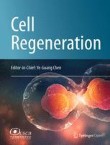Cell Regeneration is the official journal of the Chinese Society for Cell Biology
Adipose tissue-derived mesenchymal stem cells and chitosan/poly (vinyl alcohol) nanofibrous scaffolds for cartilage tissue engineering
Osteoarthritis (OA) has been defined as a chronic inflammatory joint disease characterized by progressive articular cartilage degeneration. Recently growing interest in regenerative medicine, using cell therap...
